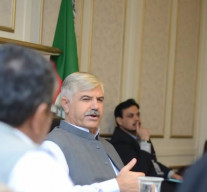
But that is too optimistic to say the least. There is nothing in sight to suggest that exports will pick up that fast and meet the difficult target.
We as a nation are notoriously good at setting big targets and missing them again and again. When General Pervez Musharraf took over reins of the country, he gave visions after visions for taking the economy to new heights.
Engineers can easily recall his Engineering Vision 2005 that promised to enhance exports of engineering products to the magical $1 billion by 2005 from less than $100 million in 2000. In FY18, 13 years after the end of deadline for increasing engineering goods exports to a billion dollars, proceeds from such exports, after rising to $207 million, slipped to about $173 million, according to data released by the Pakistan Bureau of Statistics.
Pakistan’s engineering sector has continued to suffer from low investment in both public and private-sector engineering enterprises as well as from the dearth of professional engineers. Engineering graduates of top-level universities often find jobs overseas and those left behind serve in a rotten system that does not encourage innovative minds.
High fiscal deficits make it difficult for governments to pour money into the engineering sector. The private sector also does not bother to pump extra funds into the capital-intensive engineering industry.
Most industrialists in Pakistan have lately become rent-seekers. For them, opportunities for making a quick buck through speculation-driven businesses keep popping up.
Exports of engineering goods include electric fans, buses, trucks, tractors, cars, motorcycles, rickshaws, auto parts, electrical machinery of all types, machinery for road and building construction, industrial boilers, a few agricultural machinery and parts of sugar and cotton ginning mills.
Untapped potential
In each of these categories, there is a lot of potential. But that potential is not being exploited for the following reasons:
- Our governments normally focus on big-ticket export items like textile and do not give due importance to other exportable goods.
- Pakistan Engineering Council keeps coming up with reports after reports on what to do for boosting exports of engineering goods but it does not provide a common platform where young entrepreneurs can learn from experienced experts of this field.
- Domestic demand for electric fans remains high and, as such, makers of electric fans do not make enough efforts to increase exports.
- Most of the engineering goods manufacturing takes place in Punjab and many products, particularly electric fans, are smuggled to Afghanistan and even from there to Central Asia.
- Owing to the bad law and order situation in Karachi before the operation cleanup, Karachi-based manufacturers of engineering goods lost business in domestic and foreign markets.
- No effort has been made to help businessmen set up engineering industrial units in Balochistan.
With little investment, the light engineering industry can be promoted. If the government offers financial and technical help to the young engineers graduating from universities, they can surely produce some light engineering goods like auto parts, solar-powered fans, small-scale wheat and rice milling units, etc.
This can be done initially in Karachi where the industries have suffered a lot due to poor law and order situation which prevailed until a few years ago.
But going forward, this can also be done in Balochistan – the province where industrialisation should be promoted on a wide scale to address complaints of joblessness by the educated Baloch youth.
Production cost
For promoting exports of engineering goods, or for that matter any other product, it is important to keep their cost of production low. The government should ensure that raw material and utilities are available to the producers of engineering goods at affordable prices.
Banks should provide them capital at affordable rates. We continue to hear that big textile and sugar mills with political backing default on bank loans. Banks must ensure that such defaults are minimised and more loans are offered to the engineering and other industries.
Export marketing is also undergoing big changes these days. For promoting exports of engineering goods, it is also necessary that the exporters adopt new methods of marketing, especially by making greater use of the internet.
We keep hearing about big engineering goods exhibitions but when we go there we are not very much impressed by the presentation of engineering goods manufacturers. If they cannot impress local people, how can they encourage foreigners and sell their products to them?
Last but not the least, there should be greater coordination between engineering industries and the faculty teaching at engineering universities. In the absence of this coordination, the engineering education standards will remain low and engineering industries will not be able to hire talented workers who can boost their businesses.
The writer is a mechanical engineer and is doing masters
Published in The Express Tribune, October 14th, 2019.
Like Business on Facebook, follow @TribuneBiz on Twitter to stay informed and join in the conversation.






























1714024018-0/ModiLara-(1)1714024018-0-270x192.webp)










COMMENTS
Comments are moderated and generally will be posted if they are on-topic and not abusive.
For more information, please see our Comments FAQ